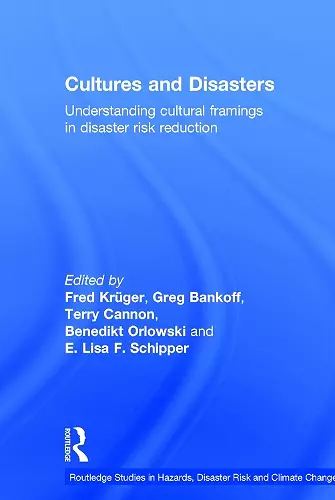Cultures and Disasters
Understanding Cultural Framings in Disaster Risk Reduction
Fred Krüger editor Greg Bankoff editor E Lisa F Schipper editor Terry Cannon editor Benedikt Orlowski editor
Format:Hardback
Publisher:Taylor & Francis Ltd
Published:24th Apr '15
Currently unavailable, and unfortunately no date known when it will be back
This hardback is available in another edition too:
- Paperback£49.99(9780415745604)

Why did the people of the Zambesi Delta affected by severe flooding return early to their homes or even choose to not evacuate? How is the forced resettlement of small-scale farmers living along the foothills of an active volcano on the Philippines impacting on their day-to-day livelihood routines? Making sense of such questions and observations is only possible by understanding how the decision-making of societies at risk is embedded in culture, and how intervention measures acknowledge, or neglect, cultural settings. The social construction of risk is being given increasing priority in understand how people experience and prioritize hazards in their own lives and how vulnerability can be reduced, and resilience increased, at a local level.
Culture and Disasters adopts an interdisciplinary approach to explore this cultural dimension of disaster, with contributions from leading international experts within the field. Section I provides discussion of theoretical considerations and practical research to better understand the important of culture in hazards and disasters. Culture can be interpreted widely with many different perspectives; this enables us to critically consider the cultural boundedness of research itself, as well as the complexities of incorporating various interpretations into DRR. If culture is omitted, related issues of adaptation, coping, intervention, knowledge and power relations cannot be fully grasped. Section II explores what aspects of culture shape resilience? How have people operationalized culture in every day life to establish DRR practice? What constitutes a resilient culture and what role does culture play in a society’s decision making? It is natural for people to seek refuge in tried and trust methods of disaster mitigation, however, culture and belief systems are constantly evolving. How these coping strategies can be introduced into DRR therefore poses a challenging question. Finally, Section III examines the effectiveness of key scientific frameworks for understanding the role of culture in disaster risk reduction and management. DRR includes a range of norms and breaking these through an understanding of cultural will challenge established theoretical and empirical frameworks.
"Cultural profiles play a crucial and often underestimated role not only in the science, but also in the practice of risk and crisis management. This discussion can’t be limited to the large scale patterns between societies and continents, but should include the diversities within a society or geographical region, creating awareness on the range of perspectives, attitudes and priorities within different societal sectors. It is one of the major strengths of this very timely book that it addresses the many ways and levels in which cultures can influence disaster risk."
Professor Jakob Rhyner, UNU-EHS Bonn
"At last … the long-awaited, definitive book that explores the complexities of culture and disaster risk. Cultures and Disasters is a highly ambitious work that interprets the subtle dimensions of the management and reduction of risk. The authors consider diverse questions that include the philosophy of risk, politics and power relationships, local knowledge and learning, social divisions, religion, celebrity culture, coping strategies and adaptive behaviour. Researchers, students and practitioners will all benefit richly from this splendid work produced by five eminent editors and over twenty international experts in the field."
Ian Davis, Visiting Professor in Disaster Risk Management in Copenhagen, Lund, Kyoto and Oxford Brookes Universities
"The Sendai Framework for Disaster Risk Reduction 2015–2030 over the next 15 years aims to achieve 'the substantial reduction of disaster risk and losses in lives, livelihoods and health and in the economic, physical, social, cultural and environmental assets of persons, businesses, communities and countries’. This timely book with its case studies enable a wider understanding of the cultural issues surrounding disasters."
Virginia Murray, Public Health England
"This collection of essays provides a much needed intervention in the field of disaster risk reduction. Its contributors represent some of the most eminent scholars in the field, providing insight into the socially embedded nature of risk and the contextual nature of people’s perceptions, interpretations, and reactions to hazards."
Zehra Zaidi, Natural Hazards Observer
"Both a book with highly usable chapters for students and innovative chapters that further the research agenda, the editors are to be commended for taking on such a challenge and providing the research community with a go-to book for anyone approaching the sticky subject of culture and disasters."
Olivia Wilkinson, Journal of International Humanitarian Action
ISBN: 9780415745581
Dimensions: unknown
Weight: 544g
282 pages